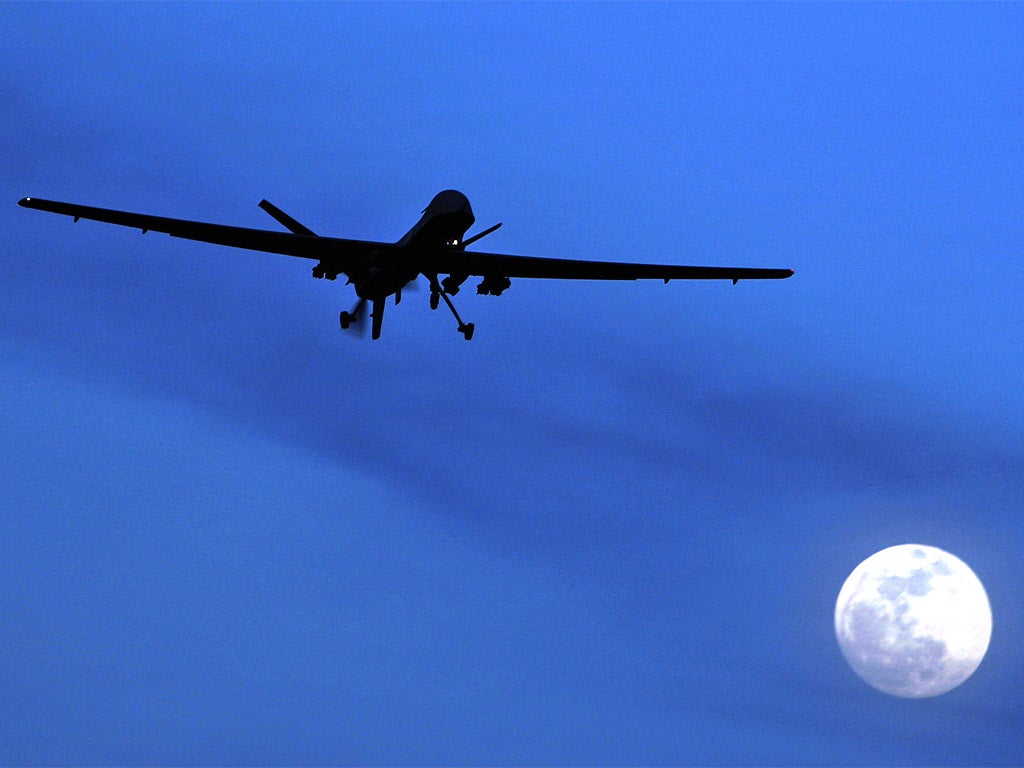Look to the skies: How the drone revolution could be coming to the US
Watch out, within five years 7,500 drones may be plying American airspace

We know now that this country is more adept at snooping than protecting privacy rights. But on the whole I can live with the National Security Agency burrowing into my every fibre-optic communication even if it means they've rumbled my pug-cam addiction. After all, who wants to live through a 9/11 twice?
I did say so far. That awful whirring sound you hear is a tiny drone and soon it will be right above you to check you are not cycling through a red light or sleeping with your neighbour's wife. Never mind Big Brother; we need to talk about Big Bird.
These days, pilotless aircraft aren't just flying over foreign lands zapping “terrorists”. Michael Huerta, who runs the Federal Aviation Administration (FAA), predicts that within five years 7,500 drones will be plying America's airspace. That compares with the 5,000 commercial aircraft in the sky in any usual daytime hour.
I saw my first two weeks ago, during a seminar held in a glass-box meeting space a few storeys up. As part of a documentary project a camera-carrying drone hovered throughout outside the windows. Fortunately nothing went awry. But this summer one drone crashed into the side of a skyscraper in Manhattan and hit the deck. Another filming a bull-run in Virginia injured four when it ploughed into a spectator stand.
As usual, the feds are playing catch-up. The FAA two weeks ago released what it called a “road map” for agreeing the safety rules for drone flights in America. It will designate six test sites around the country where would-be operators will demonstrate what their flying weasels can do and the FAA can decide what those rules should be, like keeping them away from real aircraft. It promises to have it done by September 2015. Until then it is keeping on top of matters approving drone use on a case-by-case basis.
Or so it claims. But when you can go on Amazon and buy a Parrot Quadcopter for just $299 (£184) – a kind of flying spider with four rotors sturdy enough to carry a video or still camera – it should be obvious that the FAA can't possibly know who is out there already directing their own private drone missions.
More importantly, the 70-page FAA document is nearly all about safety while it pays only lip service to what should be concerning us just as much – how the coming swarms will corrupt our privacy even further. “It's what we do best,” the papers says about keeping drone traffic safe, before adding: “It's still to be determined what part of the government will ultimately be responsible for [drone] privacy protection.”
This is hardly reassuring.
There is no point in hoping that the sudden interest in civilian drones will fizzle and die. There are scores of ways in which they will become indispensable to all manner of people.
Journalists will use them, for example to get a look at natural disaster or combat zones. Indeed, CNN used drone footage of the cyclone devastation in the Philippines. Anyone trying to survey hard-to-access areas – oil companies, search and rescue teams, environmentalists and so on – will rush to deploy them.
But so will people with more nefarious intentions. Celebrities might want to ponder the matter as the paparazzi-brigade realises it can take its game into airspace. Ask Tina Turner whose August wedding in Switzerland was disturbed by an uninvited camera-loaded drone. The possibilities for those who govern us similarly to abuse these sometimes invisible flying-spying-eyes should also make us shudder.
“What's to prevent all these commercial operators from sharing the vast treasure trove of data that they collect with the government?” asks Jennifer Lynch, of the Electronic Frontier Foundation, an anti-surveillance activist group. “Drones present new issues and they include the fact that drones can fly at various altitudes that makes them impossible to see.”
Most Americans surely didn't know that more than 80 police departments are already using drones to expand their gaze on us until Joe Arpaio, the controversial sheriff of Maricopa County in Arizona, which encompasses Phoenix, blurted last week how badly he wanted one.
“A place in Russia said I have a fleet of drones,” he exclaimed “A fleet? I don't even have one yet.” But when he does will he use it to chase crooks only or will he indulge in his well-documented habit of harassing members of the Hispanic community who may or may not be in the US legally? A federal court has already ruled his department guilty of illegal discrimination in its efforts to identify and deport anyone without papers.
The work of a Peeping Tom got easier with the invention of the ladder and then the long lens. But put them up in the air – whether they are perverts, the police or the paparazzi – and none of us will dare open our curtains ever again.
Join our commenting forum
Join thought-provoking conversations, follow other Independent readers and see their replies
Comments
Bookmark popover
Removed from bookmarks